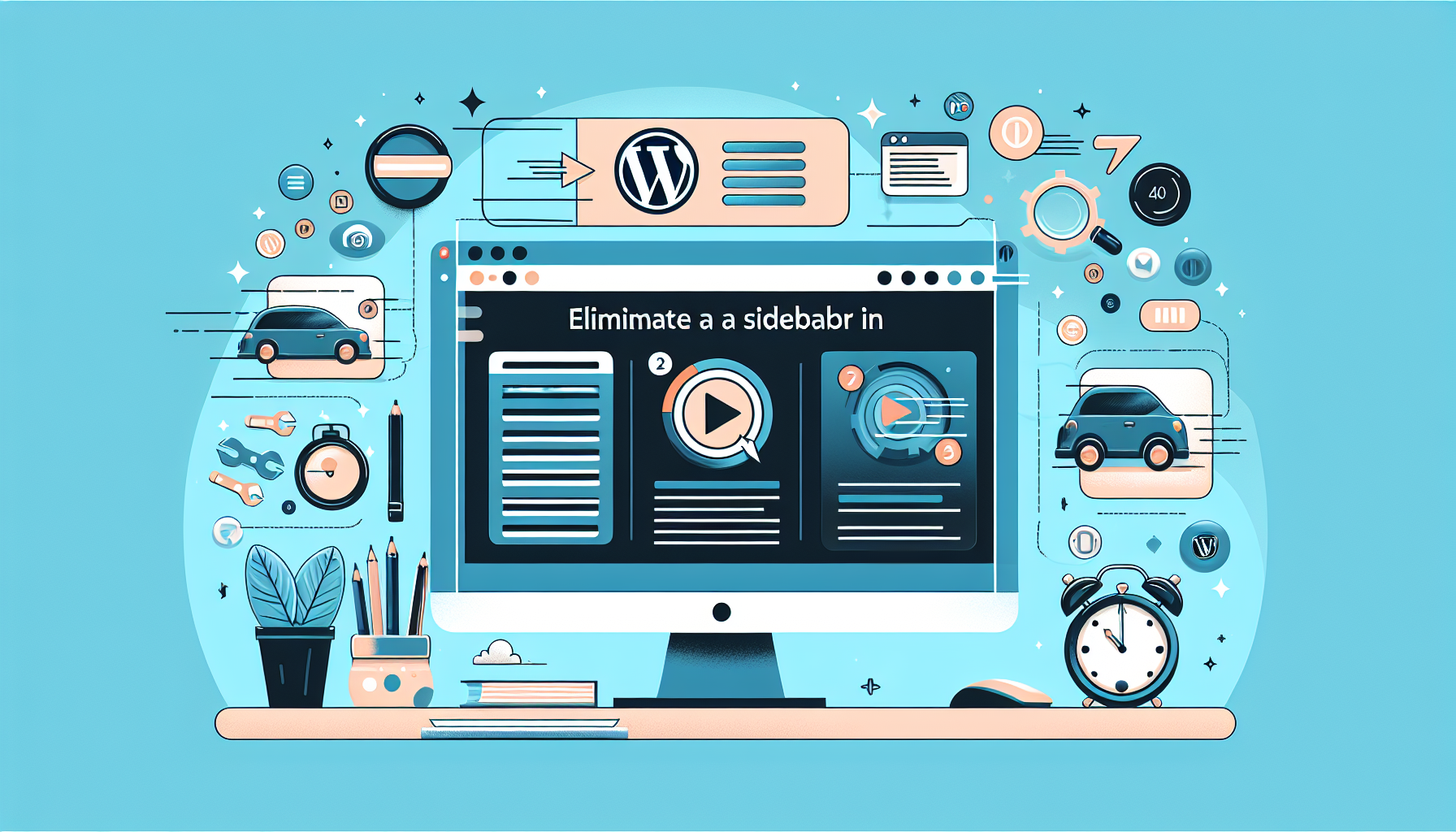Choosing the right e-commerce platform is one of the most critical decisions you’ll make when launching your online business. It shapes everything, from storefront design to how you manage inventory. With so many options out there, how do you decide? Today, two titans dominate the e-commerce scene: Shopify and WordPress. Let’s dive into the nuances of each to help you choose the perfect foundation for your digital storefront.
The Rising Demand for Online Storefronts in Today’s Digital Marketplace
The shift towards online shopping has been accelerating in recent years. The ability to buy goods from the comfort of your home is irresistible. As a business owner, now is the ideal time to tap into this vast digital market by creating your online store. But success involves selecting a platform that aligns with your specific needs and vision.
What is Shopify?
Shopify is a fully hosted, all-in-one e-commerce platform. Think of it as your digital landlord – they handle the technical aspects of website hosting, security, and maintenance. You get a set of powerful tools built specifically for selling products online. Shopify is particularly attractive for its ease of use and the speed with which you can get a professional-looking store up and running.
What is WordPress?
WordPress is a highly flexible, open-source content management system (CMS). At its core, WordPress was designed for blogging, but its versatility has transformed it into a powerhouse capable of building almost any kind of website. E-commerce functionality is primarily achieved through the world-famous WooCommerce plugin.
Let’s dissect the two types of WordPress hosting relevant for e-commerce:
- Hosted WordPress: Similar to Shopify, this involves paying a hosting provider to take care of the technical aspects of your website. Think of providers like WordPress.com or Bluehost.
- Self-hosted WordPress: This option offers maximum control and customization but demands greater technical know-how. You’ll install WordPress on a server you manage, giving you full power over every aspect of your store.
Understanding Shopify
Shopify Simplified: An E-commerce Powerhouse
Shopify has become a dominant force in the e-commerce world for good reason. This hosted platform offers businesses everything they need to create and manage a successful online store. The secret to their success is a focus on simplicity and powerful out-of-the-box features, without requiring advanced coding knowledge.
Key Features That Set Shopify Apart
- Intuitive Interface: Shopify’s strength lies in its user-friendliness. Even those who have never built a website before can confidently launch a visually appealing and functional store thanks to Shopify’s drag-and-drop website builder.
- Inventory Management: Track stock levels, receive low-stock alerts, and easily manage product listings with Shopify’s built-in inventory system.
- Payment Processing: Shopify offers its own payment gateway (Shopify Payments), plus integrates with dozens of popular providers, including PayPal, Stripe, and more. This means hassle-free, secure payment acceptance.
- Themes and Customization: A vast collection of pre-designed themes (both free and paid) provide a great starting point for your store’s design. Further customize with user-friendly tools to tailor the look and feel to your brand image.
- Shopify App Store: Extend your store’s functionality beyond the built-in features with thousands of third-party apps. These apps handle everything from marketing and email automation to dropshipping and complex product configuration.
- Support: Shopify provides 24/7 customer support through phone, email, and live chat. They also maintain a robust help center with articles and video tutorials.
Pricing Plans: Understanding Shopify’s Cost Structure
Shopify offers several pricing plans to suit businesses of different sizes and needs. It’s essential to choose the right plan to avoid unnecessary costs or outgrowing your package later. Here’s a simplified chart of their most popular offerings:
| Plan Name | Monthly Cost | Key Features | Ideal For |
|---|---|---|---|
| Basic Shopify | $29 | Basic store features, 2 staff accounts | Startups and small businesses testing the waters |
| Shopify | $79 | Everything in Basic, plus gift cards, reports | Growing businesses ready for expansion |
| Advanced | $299 | All features, lower transaction fees, reports | Large businesses with high sales volume |
Important: Transaction fees apply to each plan, unless you use Shopify Payments. Other costs can include paid themes and paid apps.
As of the latest available data, Shopify is used by over 4,628,418 live websites. This indicates a significant presence in the e-commerce platform space, showcasing its widespread adoption among online businesses.
WordPress, through its WooCommerce plugin for e-commerce, powers an even larger portion of the web. Given WordPress’s extensive use as a content management system, coupled with WooCommerce for e-commerce functionalities, it’s estimated that a substantial percentage of websites utilize WordPress for various purposes, including e-commerce.
Both Shopify and WordPress (via WooCommerce) are major players in the online business and e-commerce platform market, each serving a vast number of users with their comprehensive features and capabilities.
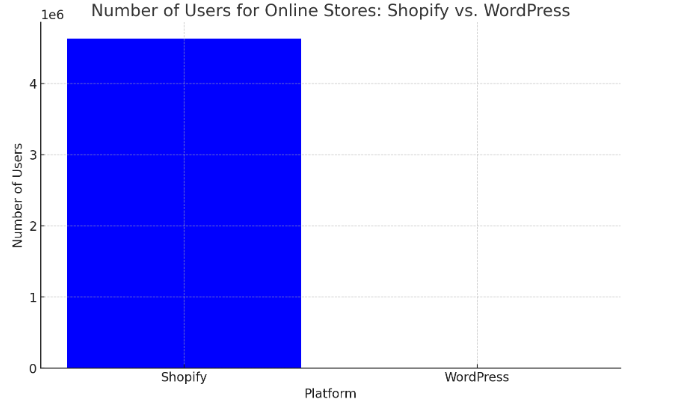
Shopify vs. WordPress: Deciding Factors
While Shopify shines for its simplicity, WordPress with WooCommerce offers unmatched flexibility. Here are a few key points when deciding:
- Ease of Use: Shopify wins hands down if you lack technical experience.
- Customization: WordPress with WooCommerce offers far more control over every aspect of your store, but may require coding knowledge or a developer.
- Costs: Shopify’s fixed monthly fees are predictable. WooCommerce on self-hosted WordPress can be cheaper but requires more technical upkeep.
Ease of Use and Setup
One of the most critical factors when choosing your e-commerce platform is how easy it is to use. After all, you want to spend your time growing your business, not wrestling with complex technology. Let’s see how Shopify and WordPress compare in this area.
How Easy Are They to Use?
- Shopify is Easier to Use
Shopify’s claim to fame is its exceptional ease of use. If you’re new to building websites, Shopify offers a much more beginner-friendly experience. Its intuitive interface, drag-and-drop editing tools, and lack of technical setup make it easy to get your store running quickly, even if you have no prior coding or web design knowledge.
- WordPress Requires More Technical Know-How
WordPress, especially self-hosted WordPress with WooCommerce, isn’t inherently difficult to use. However, there’s definitely a steeper learning curve. You’ll need to be familiar with concepts like hosting, domain setup, and potentially some coding for advanced customization. While WordPress offers unparalleled flexibility, that flexibility does come at the cost of extra setup complexity.
Getting Started: Shopify’s User-Friendly Approach
- Quick and Simple Signup: Shopify offers a straightforward signup process. Just enter some basic information, and you can begin building your store almost immediately.
- Guided Walkthroughs: Shopify helps you at every step of the way. Clear setup instructions and wizards walk you through adding products, configuring payment options, and customizing your store’s appearance.
- Intuitive Drag-and-Drop Tools: Designing your storefront feels effortless, even without coding knowledge, thanks to their drag-and-drop website builder and vast theme library.
WordPress: Customization at Your Fingertips, But at What Cost?
- Multi-Step Setup: Setting up WordPress with WooCommerce requires several more steps. You’ll need to find a hosting provider, install WordPress, install WooCommerce, and then configure the plugin’s settings.
- Potential Technical Hurdles: While not extremely difficult, this process presents a steeper learning curve, especially if you’re unfamiliar with hosting, domain names, and basic web administration.
- Customization Power: WordPress is inherently more customizable, but this freedom comes with the cost of potentially needing to learn some basic coding or rely on plugins to achieve the features you desire.
What’s the Build Time Like with Shopify and WordPress?
- Shopify Has a Quicker Build Time
You can realistically launch a fully functioning Shopify store in a matter of days, potentially even hours, depending on the complexity of your products and design. Shopify’s streamlined setup and out-of-the-box features save you immense time.
- WordPress Build Time Is Highly Variable
WordPress build time depends entirely on several factors: your technical knowledge, the complexity of your store, whether you use pre-built themes or design from scratch. A simple WooCommerce store could be done in a week or two, while a highly customized one could take months.

Expert Tip: Let’s be honest, building any successful online store takes dedication and effort. However, if you want the quickest path to launch without sacrificing the professionalism of your storefront, Shopify is the clear winner in the ease-of-use category.
Diving Into WordPress
WordPress: Not Just for Blogging Anymore
WordPress has transcended its origins as a humble blogging tool. Today, it’s a robust content management system (CMS) capable of powering virtually any type of website, including thriving online stores. This incredible diversity is one of WordPress’s biggest strengths.
Leveraging WooCommerce for E-commerce on WordPress
WooCommerce is the go-to plugin that transforms WordPress websites into e-commerce powerhouses. It’s a free, open-source plugin that integrates seamlessly with WordPress to offer all the essential features you need to sell products online:
- Product Management: Add and organize products with ease, including variations, descriptions, and images.
- Shopping Cart and Checkout: Smooth customer experience from browsing to secure payment processing.
- Shipping and Tax Functionality: Integrates with major shipping carriers and automatically calculates taxes based on location.
- Store Management Tools: Manage orders, inventory, and customer data from your WordPress dashboard.
Breaking Down Costs: WordPress and WooCommerce Expenses
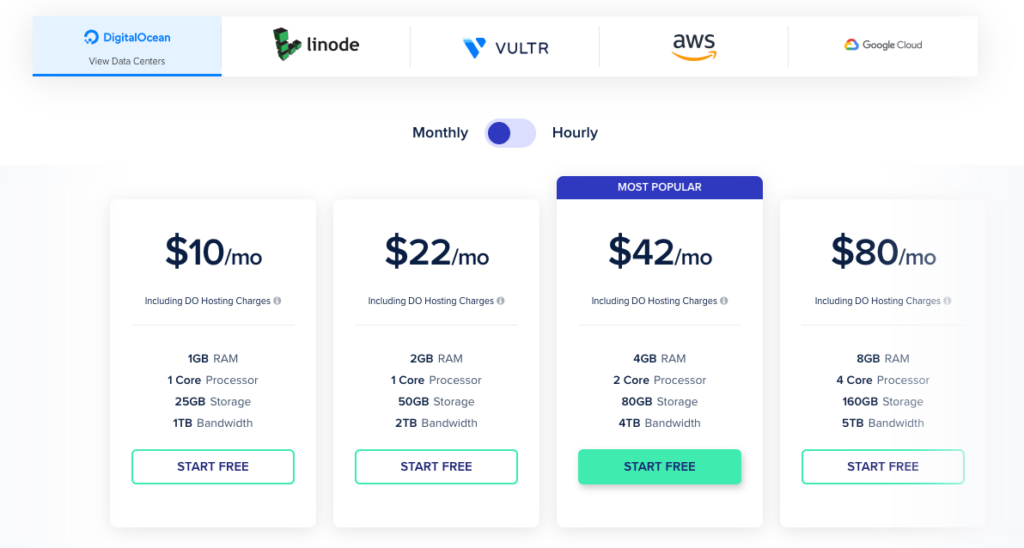
While WordPress and WooCommerce themselves are free, operating a successful online store on this platform does have associated costs. Here’s what you need to budget for:
- Hosting (Essential): You’ll need a hosting provider to make your WordPress site accessible on the web. Think of it as your website’s virtual real estate. Costs vary based on server type, traffic, and the hosting provider itself. [Include a visual example of popular hosting providers like Siteground or Bluehost]
- Domain Name (Essential): This is your store’s web address (example: [invalid URL removed]). Prices vary slightly by registrar.
- Themes (Often Optional): While free WooCommerce themes exist, a premium theme can elevate your store’s design and functionality. Theme costs range from one-time purchases to subscriptions.
- Plugins (Situational): While WooCommerce provides core e-commerce capabilities, plugins can add advanced features like subscriptions, memberships, or complex product configurations. These can be free or paid.
- Security (Crucial): Investing in strong SSL certificates and WordPress security plugins is non-negotiable to protect sensitive customer data.
Important Note: Self-hosted WordPress gives you the most control but demands a higher level of technical responsibility.
Design and Customization
The way your store looks heavily influences a shopper’s first impression and their willingness to purchase. Let’s see how Shopify and WordPress stack up when it comes to design flexibility.
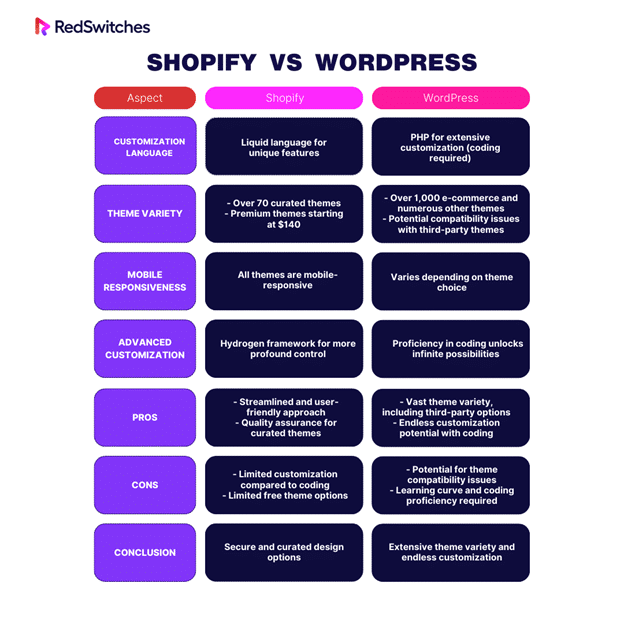
Shopify Themes: Sleek, Professional, and Ready to Go
- Theme Library: Shopify offers an extensive collection of free and premium themes. These themes are designed with e-commerce in mind, providing a polished starting point for your store.
- Easy Customization: Tweak layout, colors, and fonts without writing code. Many themes offer section-based editing, letting you drag and drop content blocks to create a unique look.
- App Integrations: Need a unique feature? The Shopify App Store offers countless design apps to extend your theme’s capabilities without getting into complex code.
WordPress: The Limitless World of Themes and Plugins
- Unmatched Theme Variety: Thousands of free and premium WordPress themes exist, plus countless more from independent developers. You’ll have no shortage of options.
- Plugins are Your Best Friend: WooCommerce plugins add everything from product layout options and mega menus to custom product filters. Want it? There’s probably a plugin for it.
- Customization Potential: If you know your way around CSS or are willing to work with a developer, you can truly make your WordPress store one-of-a-kind. The limit is your (or your developer’s) imagination.
Shopify makes achieving a professional-looking store easier, especially for non-technical users. WordPress demands more effort, but the payoff is unmatched control over the exact look and functionality of your website.
Let’s Get Practical
If you want the ability to implement unique store features that are truly tailored to your niche, WordPress may be the better fit. If you need a beautiful, functional store fast and prefer a simpler process, Shopify’s theme system has you covered.
E-commerce Features and Functionalities
The heart of a successful online store lies in robust features that make both buying and selling a smooth experience. Let’s explore what Shopify and WordPress deliver in this arena.
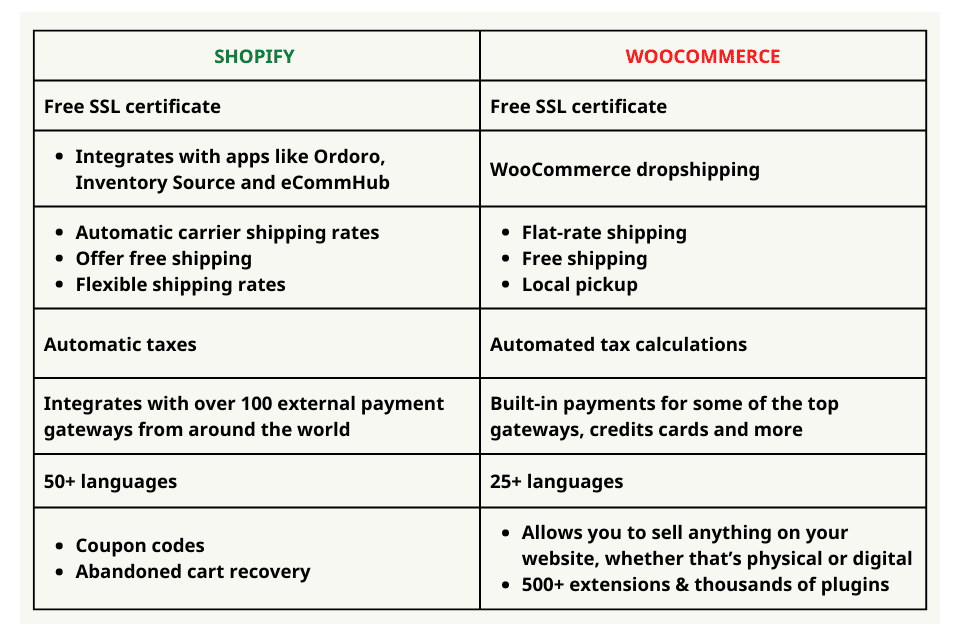
Shopify: Built for Selling from Day One
Shopify is designed with e-commerce at its core. You’ll find all the essentials for selling online baked directly into the platform with minimal setup required:
- Product Management: Easily add unlimited products, variants (think colors, sizes), set pricing, and manage inventory.
- Discount Codes and Promotions: Run sales, offer coupons, and more to drive conversions.
- Abandoned Cart Recovery: This built-in feature helps recover lost sales by reaching out to customers who abandoned their carts.
- Shipping Options: Integrate with popular carriers, offer real-time shipping rates, and manage shipping rules based on locations or order size.
WordPress and WooCommerce: Crafting a Store Your Way
WooCommerce, being a plugin, adds on the e-commerce layer to the flexible foundation of WordPress. This means a bit more initial setup, but also more flexibility for customization.
- Core Features: WooCommerce provides most of the same essential tools for listing products, taking payments, and managing orders, all within your WordPress dashboard.
- Extendability Through Plugins Want advanced subscription options? Special product bundles? Unique loyalty programs? WooCommerce’s vast plugin ecosystem makes it possible.
Ecommerce Functionality in Shopify and WordPress
Let’s compare Shopify’s out-of-the-box features to WordPress with essential WooCommerce plugins installed.
Shopify Features vs. WordPress Features
| Feature | Shopify | WordPress (with WooCommerce) |
|---|---|---|
| Product Listings | Intuitive, built-in | Straightforward, built into WooCommerce |
| Shipping Rates | Real-time calculation with carriers | Real-time calculation with carriers (plugins needed) |
| Discount Codes | Built-in functionality | Built-in functionality |
| Payment Processing | Shopify Payments + major providers | Major providers through WooCommerce or plugins |
| Inventory Management | Centralized tools | Built-in, with plugins for enhanced functionality |
WooCommerce Features : WooCommerce stands out with extensions for features like subscriptions, memberships, dynamic pricing, and many more.
Ecwid Features : It’s worth noting Ecwid is another e-commerce plugin for WordPress offering a different feature set and pricing model than WooCommerce.
Payment Options and Transaction Fees
- Shopify: Shopify Payments has low fees, but charges extra for using external payment gateways.
- WordPress: Fees depend on your payment gateway. WooCommerce itself doesn’t take a transaction cut.
Multi-Channel Commerce
This involves selling on other marketplaces (Amazon, Etsy), or social media.
- Shopify: Integrates with various marketplaces and social platforms.
- WordPress: Plugins offer integrations with varying degrees of complexity.
Design and User Experience
A beautiful and frictionless user experience (UX) is crucial for e-commerce success. Poor design can lead to confused customers and abandoned carts. Let’s see how Shopify and WordPress approach this vital aspect.
Templates and Themes
- Shopify: The Shopify Theme Store offers a wide selection of well-designed themes. Many themes are optimized for specific industries, making it easier to create a store that caters to your target audience.
- WordPress: The sheer number of WordPress themes can be overwhelming, with varying quality levels. Filtering through and selecting a truly conversion-optimized WooCommerce theme takes more effort.
Platform Design and UX
- Shopify: Shopify’s administrative backend is known for its user-friendliness. Even new sellers will find navigating and managing their store relatively straightforward.
- WordPress: WordPress’s dashboard can feel more cluttered compared to Shopify’s. Familiarity with WordPress gives you an advantage, but there’s a slightly steeper learning curve for newcomers.
Storefront Design
- Shopify: Theme customization tools are intuitive, allowing for a decent amount of personalization without coding. However, total design freedom is limited compared to WordPress.
- WordPress: You have more control over your storefront’s design with WordPress. Those familiar with code can customize to their heart’s content. Plugins can also add extra design and UX-enhancing features.
Mobile Shopping Experience for Customers
With many people now shopping on their smartphones, mobile responsiveness is non-negotiable.
- Responsive Design
- Shopify: Shopify themes are designed to be mobile-responsive, meaning they adjust to look good on various screen sizes.
- WordPress: Responsiveness depends on your chosen theme. Most reputable WooCommerce themes are optimized for mobile but double-check before purchasing.
- Load Time
- Shopify: Shopify servers are generally optimized for speed. However, large stores, unoptimized images, and poorly coded apps can slow things down.
- WordPress: Site speed depends heavily on your hosting provider, chosen theme, plugin bloat, and your own optimizations. It demands more hands-on management.
- Mobile Payment
- Shopify: Shopify Payments and most major payment gateways work seamlessly on mobile.
- WordPress: Similarly, reputable payment gateways prioritize a smooth mobile checkout experience.
Key Takeaway: Shopify usually offers a smoother design and UX journey for the merchant, especially if you don’t have development experience. WordPress demands more effort, but the trade-off is greater design flexibility.
SEO Capabilities
Search Engine Optimization (SEO) is crucial for any online store. You want your products to appear high in search results to attract organic traffic. Here’s what you need to understand about Shopify vs. WordPress in this arena.
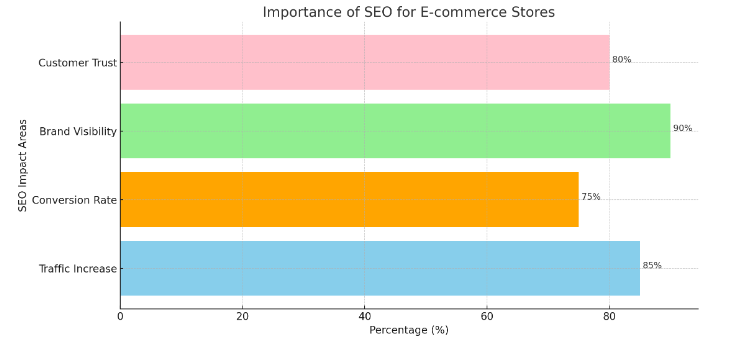
Navigating SEO on Shopify: Built-In Features for Visibility
- Basic SEO Controls: Shopify provides built-in options to edit meta titles, descriptions, URLs, and image alt-text. These are essential for on-page optimization.
- Automatic Sitemap Generation: Shopify creates an XML sitemap for you, helping search engines discover and index your website pages.
- Blog Functionality: Shopify has a built-in blogging platform. Creating valuable content is an important part of an effective SEO strategy.
- Shopify App Store: Various SEO-focused apps can add functionality for things like keyword research and optimization suggestions
WordPress: SEO Mastery with the Right Plugins
- SEO Plugins: Plugins like Yoast SEO and Rank Math give you incredible control over on-page optimization, technical SEO settings, and detailed analysis.
- Flexibility: WordPress allows for fine-tuning of aspects like URL structure, which some SEO experts prefer.
- Caveat: Overusing plugins can slow down your site, so choose wisely. Too much focus on tools can also distract from creating genuinely valuable content.
Technical SEO
- Shopify: Limited control over technical SEO aspects. You may be restricted when it comes to things like robots.txt customization or advanced redirect options.
- WordPress: Full access for those comfortable with a more hands-on approach. You have complete control over the technical SEO aspects of your site.
On-Page SEO
- Shopify: The interface for editing on-page content elements is intuitive.
- WordPress: SEO plugins usually provide easy-to-follow guidance about optimizing your product pages and blog content.
Performance and Security
These two elements indirectly impact your SEO, as search engines like Google factor them into their rankings:
- Shopify: Shopify-hosted sites tend to be very fast. However, poorly optimized themes or apps can introduce performance issues.
- WordPress: Your site speed largely depends on your hosting, theme, and the number of plugins you use. It requires active optimization efforts.
- Security Shopify handles this for you. WordPress security relies on your chosen hosting provider, proper updates, and good security practices.
Shopify simplifies the basics for those new to SEO. WordPress grants advanced control but demands more technical know-how to utilize it fully.
Security and Reliability
A secure and reliable e-commerce platform builds trust with your customers. Breaches, downtime, or slowness can seriously damage your reputation and sales.
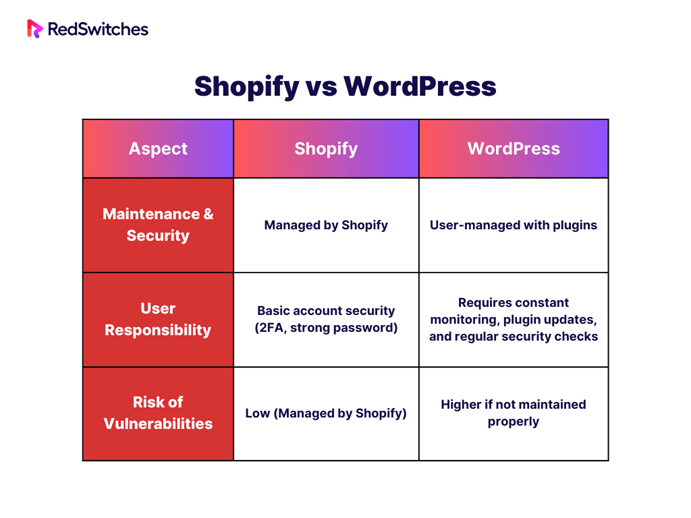
Shopify’s All-in-One Secure Hosting Solution
- PCI Compliance: Shopify handles the complexities of Payment Card Industry compliance. This is a big relief, especially for those new to e-commerce.
- SSL Certificates: Automatically included on all stores to encrypt sensitive customer data during transmission.
- DDoS Protection: They have measures in place to mitigate Distributed Denial of Service attacks, which attempt to overload your store with traffic.
- Uptime Reliability: Shopify’s infrastructure is designed to keep stores running smoothly, with minimal downtime.
Securing Your WordPress Site: Best Practices and Essential Plugins
- Strong Hosting: Choose a reputable hosting provider that prioritizes security and performance (avoid bargain-basement shared hosting).
- Updates, Updates, Updates: The WordPress core software, themes, and plugins must be updated regularly to patch vulnerabilities.
- SSL Certificate: This is non-negotiable. Talk to your hosting provider about installing one for your site.
- Security Plugins: Consider plugins like Wordfence or Sucuri, which offer malware scanning, firewalls, and security monitoring.
- Strong Passwords & User Permissions: Enforce strong passwords and limit admin access to only trusted individuals.
Important Note: Even with WordPress security plugins, vigilance is key. These tools help, but don’t make you invincible to attacks.
Shopify offers a more hands-off, secure experience by default, especially if you’re less technically inclined. WordPress puts security more in your hands, requiring active management and potentially higher costs if you need professional assistance.
Practical Questions to Consider
- Do you have the time and technical know-how to proactively maintain WordPress security, or do you prefer a solution that prioritizes it even if it costs more?
- How valuable is the peace of mind of having security handled for you, especially when dealing with sensitive customer financial data?
Compliance and Multilingual Support
Expanding your reach and remaining compliant with regulations are vital aspects of e-commerce growth. Let’s see how Shopify and WordPress handle these areas.
GDPR Compliance in Shopify and WordPress
- What is GDPR? The General Data Protection Regulation (GDPR) is a European Union law regulating how businesses collect and process personal data of EU residents.
- Shopify: Shopify offers built-in features to aid with GDPR compliance such as cookie consent tools, the ability to manage customer data requests, and templates for things like privacy policies.
- WordPress: GDPR compliance on WordPress involves more legwork. Plugins like WP GDPR Compliance can help, but full compliance demands careful store configuration and an understanding of the regulation itself.
Important Note: Regardless of the platform, consulting with a privacy lawyer about your specific store’s compliance is often a wise investment, especially if you do business with EU customers.
Creating Multilingual and Multiple Sites
- Expanding Your Reach: Offering your store in multiple languages can break down barriers and open up new markets.
- Shopify: Creating multilingual stores usually requires a third-party app, which adds additional costs. Some themes offer built-in multilingual support, but options can be limited.
- WordPress: Plugins like WPML or TranslatePress offer robust multilingual capabilities. Multilingual site setups can get complex, potentially requiring developer assistance.
Practical Considerations
- Translation Quality: Ensure your chosen multilingual solution provides options for professional-grade translation. Machine translation alone is rarely good enough for a polished online storefront.
- Multiple Sites vs. One Site: Deciding between running multiple individual stores (example: [invalid URL removed] and shopifystore.de) or a single multilingual store hinges on factors like product/inventory differences between regions and the need for truly localized content.
Shopify simplifies the basics of GDPR compliance and offers some multilingual capabilities. WordPress requires more effort but often provides deeper customization both for complex compliance scenarios and multilingual setups.
Support and Community
Knowing where to turn for help when things inevitably get tricky is crucial for e-commerce businesses. Let’s see what kind of support you get with each platform.
Shopify Support: Helping You Every Step of the Way
- 24/7 Support Channels: Shopify offers support via live chat, email, and phone around the clock. This is a major advantage for those who need immediate help, especially during critical times like sales events.
- Knowledge Base and Help Center: Shopify maintains an extensive library of articles, tutorials, and guides designed to help you understand their platform and troubleshoot issues.
- Shopify Community Forum: Connect with other Shopify merchants, exchange tips, and find answers to your questions. It’s a good resource, but not always a substitute for official support.
- Shopify Experts: If you need in-depth help, you can connect with vetted Shopify Experts (freelancers and agencies specializing in Shopify). This is often a paid service.
WordPress Community: A Global Network of Help
- Official WordPress.org Support Forums: Get support from experienced WordPress users and volunteers. Response times can vary, and quality isn’t always consistent.
- Plugin and Theme Support: Many reputable plugin and theme developers offer dedicated support, either as forums, ticket systems, or even live chat. This varies per developer.
- Vast Community Resources: Countless WordPress blogs and tutorials exist online. However, it takes effort to sift through and find reliable ones.
- Hiring Help: You can easily find WordPress freelancers and agencies to assist you. These are paid services, with costs ranging from affordable to very expensive depending on the task’s complexity.
Shopify offers a more streamlined support experience, especially for beginners. WordPress’s support is more fragmented, requiring more research and initiative on your part to get the help you need.
Scalability and Growth
Choosing a platform that can seamlessly grow alongside your business success is crucial for long-term success.
Growing with Shopify: Solutions for Scaling Up
- Predictable Pricing: Shopify’s monthly plans make it easier to budget as your sales grow. Upgrading to higher tiers unlocks more features and higher volume limits.
- Handling Traffic Spikes: Shopify’s infrastructure is designed to manage sudden influxes of traffic, giving you peace of mind during flash sales or viral moments.
- The App Store: As you grow, you can add on apps to extend functionality in areas like marketing, inventory management, and customer loyalty programs.
- Potential Limitations: High-volume stores may eventually hit Shopify’s built-in limitations for things like discount codes or API call rates. Some advanced customizations can be tricky or impossible without going the Shopify Plus (enterprise) route.
WordPress: Expanding Your Reach with Advanced Customizations
- Flexibility is King: With the right expertise, WordPress is infinitely customizable. Whether you need unique product configurations or highly specific integrations with other systems, it’s likely possible.
- Resource Control: With self-hosted WordPress, you choose your hosting provider. If your traffic surges, you can upgrade servers to ensure your store stays performant.
- Cost Considerations: This flexibility comes with responsibility. You’ll likely need a developer on hand, and scaling your hosting can become expensive with truly high traffic.
- Plugin Reliance: Some key scaling functionality is plugin-dependent, adding potential points of failure if plugins are poorly coded or become abandoned by their developers
Key Questions to Ask Yourself
- How quickly do you anticipate growing? Is it steady growth, or do you expect explosive virality?
- How complex are your product offerings and future requirements? Will you need unusual customization capabilities down the line?
- How comfortable are you managing technical aspects, or do you have a developer or the budget to hire one?
Shopify generally offers a smoother growth path, especially for non-technical users, up to a certain point. WordPress empowers you with limitless customization, but this freedom comes at the cost of higher complexity and greater responsibility for managing performance.
Making the Choice: Factors to Consider
Choosing the right e-commerce platform is a big decision. Let’s focus on the crucial factors that should influence your choice.
Identifying Your Business Needs and Goals
- Technical Expertise: How comfortable are you with managing websites, code, hosting, and troubleshooting issues? Be honest with yourself!
- Current and Future Product Catalog: Simple product offerings vs. highly complex products with many variations (think custom-configurable furniture)
- Customization Needs: How unique is your store? Do you need highly specific features or fine-grained control over every aspect of the design?
- Growth Projection: Steady, moderate growth vs. the potential for rapid, high-volume scaling needs
- Desired Level of Control: Do you prefer a more hands-off approach, or do you want full control over the technical side of your store?
Budgetary Considerations for Long-Term Growth
- Upfront Costs: Shopify has predictable monthly fees. WordPress’s core software is free, but hosting, domain, themes, and plugins come at a cost.
- Development Costs: Complex customizations on WordPress often require hiring a developer, increasing your expenses significantly.
- App vs. Integration Costs: Achieving certain features on Shopify may require paid apps, while similar functionality may demand custom development on WordPress.
Pricing and Costs
Let’s get into the nitty-gritty of pricing. It’s essential to look beyond just the basic monthly fees.
How Much Do They Cost?
| Feature | Shopify (Basic Plan) | WordPress (Self-Hosted) |
|---|---|---|
| Monthly Subscription | $29 | Varies based on hosting |
| Domain Name | $10 – $20/year | $10 – $20/year |
| Premium Theme | $0 – $300+ (one-time) | $0 – $200+ (one-time) |
| Essential Plugins | Free options available | Free options available, some key plugins are paid |
| Transaction Fees | 2.9% + $0.30 (unless using Shopify Payments) | Varies based on payment gateway |
Shopify Costs vs. WordPress Costs
- Shopify: Predictable costs, easy to budget. Potential costs include apps, premium themes, and transaction fees if you don’t use Shopify Payments.
- WordPress: More variable costs. Self-hosted WordPress can be cheaper initially but might become expensive for high-traffic or heavily customized stores.
Important Note: Costs change over time. Always verify on the official Shopify and WordPress sites for the most up-to-date pricing.
Scenario 1: Small, Simple Store
- Products: A modest selection of straightforward products (e.g., t-shirts, mugs, basic jewelry)
- Features: Core e-commerce essentials: product listings, secure checkout, basic shipping options
- Customization: Using a pre-built theme with minimal tweaks
Shopify:
- Plan: Basic Shopify ($29/month) would suffice.
- Theme: Potentially a free theme, or a premium one for a more polished look ($100 – $180 range)
- Apps: You might need a few free apps for basic things like reviews or pop-ups.
- Estimated Cost (Year 1): $450 – $700
WordPress:
- Hosting: A basic shared hosting plan is likely okay (~$5 – $15/month)
- Theme: You might find a suitable free theme, or opt for a premium option.
- Plugins: You’ll need essential plugins for e-commerce (WooCommerce), payment gateways, and security (most are free, but some offer premium versions).
- Estimated Cost (Year 1): $120 – $500
Scenario 2: Complex Store with Customizations
- Products: Large inventory, products with many variants, custom product configurations.
- Features: Specialized shipping requirements, unique membership/subscription system, integration with external inventory software.
- Customization: Significant store design changes, bespoke features requiring coding.
Shopify:
- Plan: You likely need a higher-tier plan like Shopify ($79/month) or Advanced ($299/month) for added functionality.
- Theme: A premium theme with greater flexibility, likely with some customization expenses.
- Apps: More specialized apps will be necessary, many of which have monthly fees.
- Development Costs: Potential need for a Shopify developer to implement custom features.
- Estimated Cost (Year 1): $1500 – $5000+, highly dependent on complexity.
WordPress:
- Hosting: You’ll need robust hosting suitable for a high-traffic site (VPS or dedicated hosting, $50+/month)
- Theme: A premium theme is a starting point, likely with extensive modifications.
- Plugins: Premium plugins for advanced functionality become a necessity.
- Development Costs: You’ll almost certainly need to hire a WordPress/WooCommerce developer, which can be costly.
- Estimated Cost (Year 1): $2000 – $10,000+, with the upper range reaching very high for truly complex setups.
Key Takeaways
- Simple Stores: Shopify offers a more streamlined setup with predictable costs initially. WordPress can be slightly cheaper upfront, but not always by a significant margin.
- Complex Stores: Shopify can get expensive as your customization needs escalate, and you might eventually hit platform limitations. WordPress’s costs soar with complexity, but you retain greater control.
Important Note: These are estimates. Getting accurate quotes is crucial before committing to a platform, especially for complex scenarios.
Mobile Apps and Site Management
Running a successful store often means being on-the-go. Mobile apps allow you to stay connected to your business even when you’re away from your desk.
Mobile Apps for Shopify and WordPress (show a detailed chart)
Let’s break down the mobile app offerings of each platform with a handy chart:
| Feature | Shopify Mobile App | WordPress Mobile App (Self-Hosted) |
|---|---|---|
| Basic Store Management | Yes | Yes (requires Jetpack plugin) |
| Order Processing | Yes | Yes |
| Inventory Updates | Yes | Yes |
| Product Creation | Yes | Limited |
| Customer Communication | Yes | Yes |
| Analytics and Reports | Yes | Yes |
| Push Notifications | Yes | Yes (with third-party plugins) |
Key Takeaways
- Shopify’s Edge: The Shopify app offers a polished, streamlined experience. It excels in core store management on-the-go.
- WordPress Flexibility (With a Catch): Self-hosted WordPress with WooCommerce requires the Jetpack plugin for mobile functionality. Third-party plugins could enhance its capabilities further.
Mobile Apps for Shop Owners
- Shopify:
- Ease of Use: User-friendly interface designed specifically for the platform.
- Key Features: Robust functionality for managing orders, products, customers, marketing on-the-go.
- WordPress:
- Core App + Plugins: Basic store management with Jetpack. Further enhancements depend on carefully chosen third-party extensions.
- Potential for Complexity: A curated set of plugins could provide a great mobile experience, but it requires more research and setup on your part.
Practical Questions to Consider
- Which tasks do you absolutely need to perform on your phone? Prioritize the platform whose app best aligns with those.
- How comfortable are you with vetting and configuring plugins? This impacts your experience with a WordPress-based app setup.
Final Verdict
There’s no universal ‘winner’ between Shopify and WordPress. The ideal choice depends entirely on your individual business and priorities. Let’s recap the pros, cons, and who each platform generally suits best.
Weighing the Pros and Cons: Shopify vs. WordPress
Let’s summarize the main arguments for and against each option:
The Winner Is: Tailoring the Decision to Your E-commerce Vision
The real key to making the decision is asking yourself the right questions:
- How much technical knowledge and willingness to troubleshoot do you have?
- Is ease of use and a streamlined setup non-negotiable?
- Do you foresee rapid growth with the need for a platform that scales effortlessly?
- Is absolute control and unmatched customization potential your top priority?
Reasons to Use Shopify vs. WordPress
Choose Shopify if:
- You’re a non-technical entrepreneur who wants to launch your store quickly.
- Predictable pricing and a hassle-free setup are important.
- You don’t require extensive customizations out of the gate.
- You want excellent built-in support and want to minimize troubleshooting time.
Reasons to Use WordPress vs. Shopify
Choose WordPress if:
- You’re comfortable managing websites, code, and handling potential technical issues.
- Complete control over every aspect of your store is a must.
- You have unique requirements that Shopify is unlikely to support natively.
- You anticipate complex customizations and are willing to invest in development.
The Importance of Future Growth
Consider not only your current needs but also project where you want your business to be in 1-2 years. Here are some scenarios:
- Potential Shopify Limitation: Reaching a point where customization is essential, but Shopify’s structure limits you, might mean a costly migration later.
- The WordPress Trap: Spending heavily upfront on a complex WordPress site, but never using most of the customized features is wasteful.



